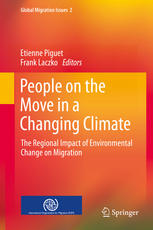

Most ebook files are in PDF format, so you can easily read them using various software such as Foxit Reader or directly on the Google Chrome browser.
Some ebook files are released by publishers in other formats such as .awz, .mobi, .epub, .fb2, etc. You may need to install specific software to read these formats on mobile/PC, such as Calibre.
Please read the tutorial at this link: https://ebookbell.com/faq
We offer FREE conversion to the popular formats you request; however, this may take some time. Therefore, right after payment, please email us, and we will try to provide the service as quickly as possible.
For some exceptional file formats or broken links (if any), please refrain from opening any disputes. Instead, email us first, and we will try to assist within a maximum of 6 hours.
EbookBell Team

5.0
98 reviewsPolicymakers around the world are increasingly concerned about the likely impact of climate change and environmental degradation on the movement of people. This book takes a hard look at the existing evidence available to policymakers in different regions of the world. How much do we really know about the impact of environmental change on migration? How will different regions of the world be affected in the future? Is there evidence to show that migration can help countries adapt to environmental change ? What types of research have been conducted, how reliable is the evidence? These are some of the questions considered in this book, which presents, for the first time, a synthesis of relevant research findings for each major region of the world.
Written by regional experts, the book provides a comprehensive overview of the key findings of existing studies on the linkages between environmental change and the movement of people. More and more reports on migration and the environment are being published, but the information is often scattered between countries and within regions, and it is not always clear how much of this information is based on solid research. This book brings this evidence together for the first time, highlighting innovative studies and research gaps. In doing this, the book seeks to help decision-makers draw lessons from existing studies and to identify priorities for further research.